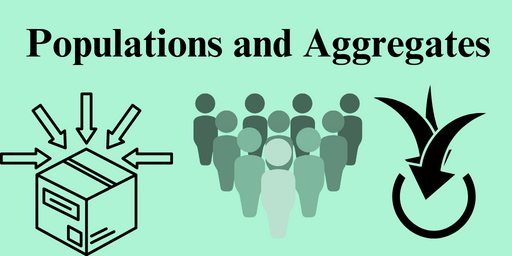Aggregates of Population In Nursing Research

Populations and Aggregates in the View of Statistics
In a very broad sense, the term population refers to a collection of entities that have one or more characteristics in common.
According to Kendall and Buckland (1960), “in statistical usage the term 'population' is applied to any infinite collection of individuals. It has displaced the older term 'universe'... it is practically synonymous with 'aggregate' and does not necessarily refer to a collection of living organisms” (p. 223).
The conception of population is basic to an understanding of inductive or inferential statistics. Stated succinctly by Blalock (1960), “the purpose of statistical generalizations is to say something about various characteristics of the populations studied on the basis of known facts about a sample drawn from that population or universe” (p. 89).
In statistics, population characteristics are called parameters and are denoted by Greek letters; sample characteristics, called statistics, are denoted by Roman letters. According to Blalock, in inductive statistics “it is the population, rather than any particular sample, in which we are really interested.”
As a matter of convenience, a sample is
selected but the goal is “practically always to make inferences about various
population parameters on the basis of known, but intrinsically unimportant
sample statistics” (p. 90). The underlying foundation for making inferences
from samples to the population is the mathematical theory of probability.
In Epidemiology Public Health and Nursing Research
Within the health field, particularly in public health, the disciplines of epidemiology and biostatistics, and the nursing specialization of public health nursing, the term population usually refers to biological entities such as people, animals, or microorganisms that hold characteristics in common.
Population has a very prominent position in epidemiology. In discussing the classical understanding of epidemiology, JN Morris (1964) referred to it as “the study of the health and disease of populations” (p. 4). More recently, Mausner and Kramer (1985) defined epidemiology as “the study of the distribution and determinants of diseases and injuries in human populations” (p. 1).
Historically, public health specialists such as health officers focused on populations and subpopulations as the target for planning, service programming, and evaluation efforts.
Although public health nurses provided clinical services in public health programs directed to target populations such as children under 6 years or prenatal clients, predominant focus was clinical, at the level of the patient or the family. The concept of using a population or aggregate approach to the 6 practice of public health nursing first began to be seriously discussed in the literature in the 1970s (Williams, CA, 1977).
The
conceptual shift from a focus on individual patients, the thrust in the clinical
preparation of nurses, to a focus on populations, which is the concern of
public health, can be difficult. However, it is necessary to understand public
health and the specialization of public health nursing.
Health Care Approaches and Population
Taking a population approach to decision making in health care, that is, defining problems and proposing solutions for a population or aggregate, may facilitate health services and care delivery research and the utilization of research in practice for two reasons.
First, such an approach involves obtaining data on each member of the population and summarizing it in meaningful ways. Adopting strategies and methods used by nurse researchers, epidemiologists, and others who study community-based or clinical populations may be used.
This process may be sufficiently systematic and rigorous to make a contribution to the research literature. Second, a population approach to decision making is highly compatible with the empirical thinking of researchers.
Specification of a Sample
Researchers study samples of populations with specific characteristics. The extent to which a finding in a sample from a particular population can be predicted in another can be assessed primarily by determining the comparability between the populations.
If the individuals in a clinical or community-based
program were identified as a population or subpopulation, with key
characteristics in common, rather than unique individuals, the program
population could be compared with another studied population.
Population Focused Approach and Outcomes
Although a population focused approach has traditionally been central to public health practice, the spread of capitated managed care has precipitated a growing interest in the concept of populations and decision making at the population level throughout the health care industry.
The
population emphasis has many positive implications for health services and care
delivery research and for a more systematic, rational, and data based approach
to decision making in the health care system.




Give your opinion if have any.